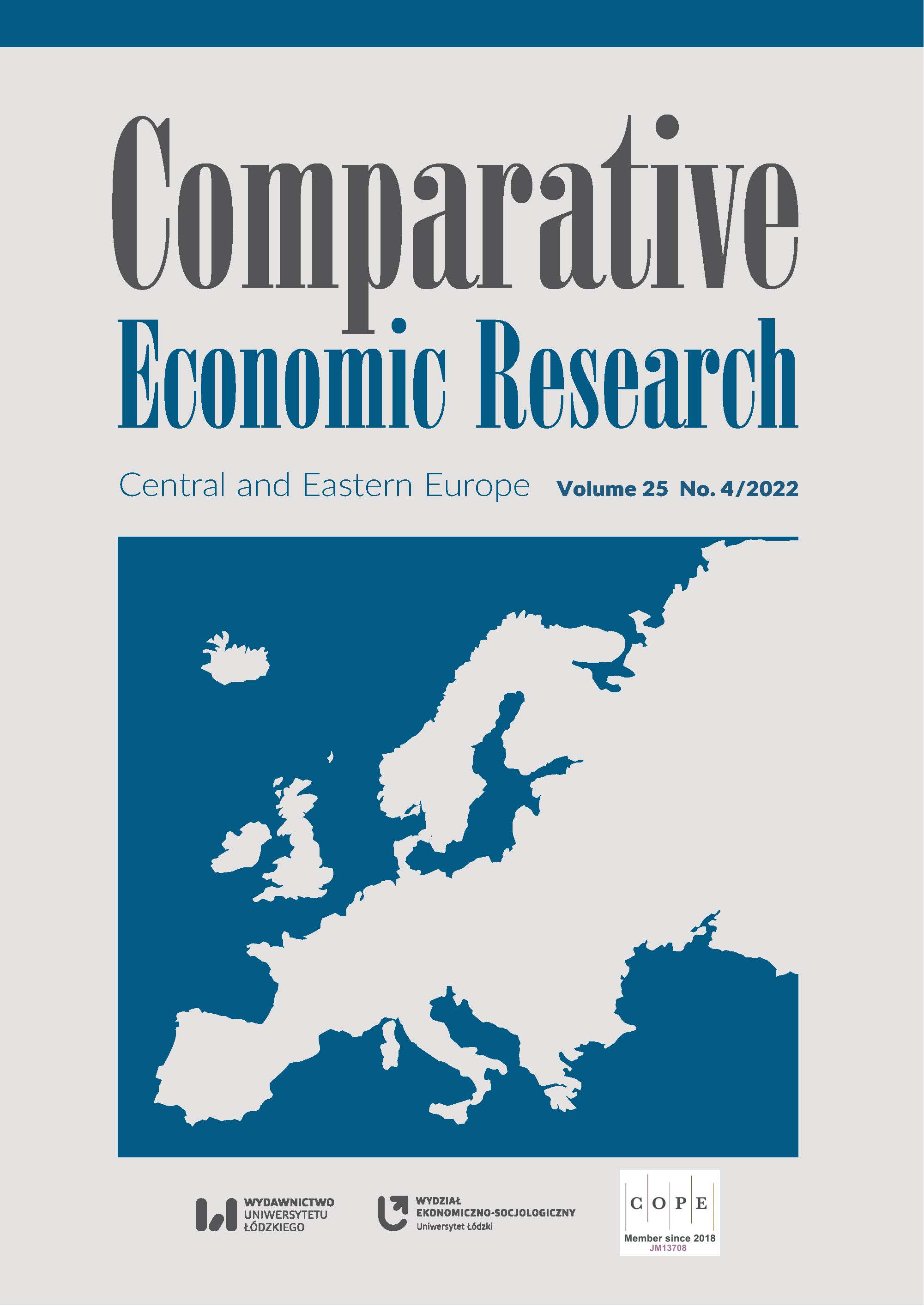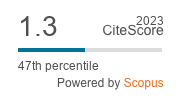The Impact of COVID–19 on EU‑China Trade Flows
DOI:
https://doi.org/10.18778/1508-2008.25.34Keywords:
COVID–19, international trade, import, export, normalized revealed comparative advantageAbstract
COVID–19 is expected to have contributed towards changing the geographical structure of world trade, including trade between individual EU countries and China. This article presents the results of an analysis of the impact of the COVID–19 pandemic on Sino‑EU trade flows. The research aims to ascertain whether European Union countries noted a strengthening of their competitive advantage in trade with China in any of the 21 HS sections by increasing the value of the normalized revealed comparative advantage index (NRCA). To identify and select the most significant NRCA observations, Chebyshev’s inequality was used. The analysis was carried out for 2015 to 2020, with a particular emphasis on 2020, when the first effects of the COVID–19 pandemic were recorded. EU‑China trade relations have been the subject of numerous studies, but their nature has not yet been fully elucidated. This article tries to fill that gap. The analysis of mutual trade, especially at such an important moment from the socio‑economic perspective, can bring significant results. The analysis revealed that the pandemic did not result in any decline in EU‑China trade. In fact, global trade rose in 2020, with most of the 27 EU countries recording increases in both imports and exports. There were also no significant changes in the structure of the distribution of comparative advantage. However, in contrast to the previously analyzed years (2015–2019), in 2020, the NRCA index shows a flatter distribution, suggesting that most EU countries with the highest comparative advantages actually observed reductions in them.
Downloads
References
China Outlook (2021), “The Deloitte Research Monthly Outlook and Perspectives”, issue 61, https://www2.deloitte.com/cn/en/pages/about-deloitte/articles/deloitte-research-issue-61.html (accessed: 10.05.2021).
Google Scholar
Ambroziak, Ł., Chojna, J., Gniadek, J., Kępka, H., Strzelecki, J. (2021), Szlaki handlowe po Pandemii Covid–19, PISM, Warszawa.
Google Scholar
Balassa, B. (1965), Trade liberalization and revealed comparative advantage, “The Manchester School of Economic and Social Studies”, 33 (2), pp. 99–123, https://doi.org/10.1111/j.1467-9957.1965.tb00050.x
Google Scholar
DOI: https://doi.org/10.1111/j.1467-9957.1965.tb00050.x
Balassa B., (1989), Comparative Advantage, Trade Policy and Economic Development, Harvester Wheatsheaf, New York.
Google Scholar
Baroowa, S. (2021), Adopting a China+1 Strategy in ASEAN. Diversifying Supply Chain to Minimize Risks, https://www.dezshira.com/multimedia/view/adopting-china-1-strategy-asean-diversifying-supply-chains-minimize-risks.html (accessed: 15.03.2021).
Google Scholar
China overtakes US as EU’s biggest trading partner (2021), BBC, https://www.bbc.com/news/business-56093378 (accessed: 8.04.2021).
Google Scholar
Dalum, B., Laursen, K., Villumsen, G. (1998), Structural change in OECD export specialization patterns: de-specialization and stickiness, “International Review of Applied Economics”, 12, pp. 423–443, https://doi.org/10.1080/02692179800000017
Google Scholar
DOI: https://doi.org/10.1080/02692179800000017
European Commission (2021a), China, https://ec.europa.eu/trade/policy/countries-and-regions/countries/china/ (accessed: 10.04.2021).
Google Scholar
European Commission (2021b), COVID–19: Waiving VAT and customs duties on vital medical equipment, https://ec.europa.eu/taxation_customs/covid-19-taxud-response/covid-19-waiving-vat-and-customs-duties-vital-medical-equipment_en (accessed: 11.05.2021).
Google Scholar
Eurostat (2021a), Real GDP growth rate – volume, https://ec.europa.eu/eurostat/databrowser/view/tec00115/default/table?lang=en (accessed: 22.05.2021).
Google Scholar
Eurostat (2021b), China-EU – international trade in goods statistics, https://ec.europa.eu/eurostat/statistics-explained/index.php?title=China-EU_-_international_trade_in_goods_statistics (accessed: 5.06.2021).
Google Scholar
Fakhrudin, U., Hastiadi, F.F. (2016), Impact Analysis of Normalized Revealed Comparative Advantageon ASEAN’s Non-Oil and Gas Export Pattern Using Gravity-Model Approach, “Working Paper in Economics and Business”, vol. V, No. 3.
Google Scholar
Fakhrudin, U., Hastiadi, F.F., Haidir, B.M. (2019), Impact Analysis of Normalized Revealed Comparative Advantage on ASEAN’s Non-Oil and Gas Export Pattern Using a Gravity Model Approach, [in:] F. Hastiadi (ed.), Globalization, Productivity and Production Networks in ASEAN, Palgrave Macmillan, Cham, pp. 105–145, https://doi.org/10.1007/978-3-030-16510-9_5
Google Scholar
DOI: https://doi.org/10.1007/978-3-030-16510-9_5
Greenaway, D., Milner, C. (1993) Trade and Industrial Policy in Developing Countries: A Manual of Policy Analysis, The Macmillan Press, London, https://doi.org/10.3998/mpub.14118
Google Scholar
DOI: https://doi.org/10.3998/mpub.14118
Heckscher, E. (1949), The Effects of Foreign Trade on the Distribution of Income, [in:] H.S. Ellis, L.M. Metzler (eds.), Readings in the Theory of International Trade, Blakiston, Philadelphia, pp. 272–300.
Google Scholar
Hinloopen, J., Marrewijk, C. van (2006), Comparative Advantage, the Rank-size Rule and Zipf’s Law, Tinbergen Institute Discussion Paper No. 06–1001/1, Amsterdam, https://doi.org/10.2139/ssrn.943370
Google Scholar
DOI: https://doi.org/10.2139/ssrn.943370
Hoen, A.R., Oosterhaven, J. (2006), On the measurement of comparative advantage, “Annals of Regional Sciences”, 40, pp. 677–691, https://doi.org/10.1007/s00168-006-0076-4
Google Scholar
DOI: https://doi.org/10.1007/s00168-006-0076-4
International Monetary Fund (2021), People’s Republic of China, https://www.imf.org/en/Countries/CHN (accessed: 7.05.2021).
Google Scholar
DOI: https://doi.org/10.5089/9781513568577.002
Lafay, G. (1990), La Measure des avantages comparatifs reveles, “Economie Prospective Internationale”, 41, pp. 27–42.
Google Scholar
Latruffe, L. (2010), Competitiveness, Productivity and Efficiency in the Agricultural and Agri-Food Sectors, “OECD Food, Agriculture and Fisheries Working Papers”, No. 30, https://doi.org/10.1787/5km91nkdt6d6-en
Google Scholar
DOI: https://doi.org/10.1787/5km91nkdt6d6-en
Laursen, K. (1998), Revealed Comparative Advantage and the Alternatives as Measures of International Specialisation, “DRUID Working Papers”, 98–30, DRUID, Copenhagen Business School, Department of Industrial Economics and Strategy/Aalborg University, Department of Business Studies.
Google Scholar
Laursen, K. (2015), Revealed comparative advantage and the alternatives as measures of international specialization, “Eurasian Business Review”, 5, pp. 99–115, https://doi.org/10.1007/s40821-015-0017-1
Google Scholar
DOI: https://doi.org/10.1007/s40821-015-0017-1
Liesner, H.H. (1958), The European Common Market and British Industry, “Economic Journal”, 68 (270), pp. 302–316, https://doi.org/10.2307/2227597
Google Scholar
DOI: https://doi.org/10.2307/2227597
Ohlin, B. (1933), Interregional and International Trade, Harvard University Press, Cambridge.
Google Scholar
Proudman, J., Redding, S. dan, (1998), Openness and Growth, The Bank of England, United Kingdom.
Google Scholar
Ricardo, D. (1817), On the Principles of Political Economy and Taxation, John Murray, London.
Google Scholar
Schwesernotes 2016 Level I CFA Book 1: Ethical and Professional Standards and Quantitative Methods (2015), Kaplan, Inc., USA.
Google Scholar
Trade Map (n.d.), https://www.trademap.org/Index.aspxhttps://www.trademap.org/Index.aspxhttps://www.trademap.org (accessed: 25.05.2021)
Google Scholar
Vollrath, T.L. (1991), A theoretical evaluation of alternative trade intensity measures of revealed comparative advantage, “Weltwirtschaftliches Archiv”, 127, pp. 265–280, https://doi.org/10.1007/BF02707986
Google Scholar
DOI: https://doi.org/10.1007/BF02707986
Wijnands, J.H.M., Verhoog, D. (2016), Competitiveness of the EU food industry. Ex-post assessment of trade performance embedded in international economic theory, LEI Wageningen UR, Wageningen, https://doi.org/10.18174/369980
Google Scholar
DOI: https://doi.org/10.18174/369980
World Customs Organization (n.d.), What is the Harmonized System (HS)?, http://www.wcoomd.org/en/topics/nomenclature/overview/what-is-the-harmonized-system.aspx (accessed: 5.02.2021).
Google Scholar
Yeats, A.J. (1985), On the appropriate interpretation of the revealed comparative advantage index: implications of a methodology based on industry sector analysts, “Weltwirtschaftilches Archiv”, 121, pp. 61–73, https://doi.org/10.1007/BF02705840
Google Scholar
DOI: https://doi.org/10.1007/BF02705840
Yu, R., Cai, J., Leung, P.S. (2009), The normalized revealed comparative advantage index, “The Annals of Regional Sciences”, 43 (1), pp. 267–282, https://doi.org/10.1007/s00168-008-0213-3
Google Scholar
DOI: https://doi.org/10.1007/s00168-008-0213-3
Yu, R., Cai, J., Loke, M.K., Leung, P.S. (2009), Assessing the comparative advantage of Hawaii’s agricultural exports to the US mainland market, “Annals of Regional Sciences”, 45 (2), pp. 473–485, https://doi.org/10.1007/s00168-009-0312-9
Google Scholar
DOI: https://doi.org/10.1007/s00168-009-0312-9
Downloads
Published
How to Cite
Issue
Section
License

This work is licensed under a Creative Commons Attribution-NonCommercial-NoDerivatives 4.0 International License.
Funding data
-
Uniwersytet Ekonomiczny w Krakowie
Grant numbers Project No. 4/EEE/2020/POT











